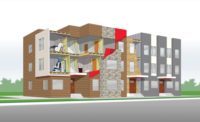In April 2020, the Gypsum Association released a completely revised Environmental Product Declaration for type X gypsum panels to replace an industry average EPD for type X panels set to expire in May 2020. This Type III, cradle-to-shipping gated EPD, summarizes environmental performance information gleaned from a life-cycle assessment. The LCA quantifies and interprets the energy and material flows to and from the environment, from cradle—mining and manufacture—to shipping gate. Environmental flows include emissions to air, water, and land, as well as the consumption of energy and material resources. In short, the EPD is a comprehensive environmental profile of this North American gypsum product.
Why EPDs?
This was an expensive and time consuming undertaking that involved all Gypsum Association member companies. Why was it necessary? The association and its member companies are committed to transparently reporting the environmental impacts of gypsum panel products, which are among the most commonly used building materials in North America. Our recently revised, updated and externally verified LCA and EPD for type X gypsum wallboard reflects efforts to contribute to more sustainable buildings.
Green building schema, including the US Green Building Council’s Leadership in Energy and Environmental Design rating system, and building codes and standards, such as the American Society of Heating, Refrigerating and Air-Conditioning Engineers standard, ASHRAE 189.1, increasingly rely upon LCA to measure environmental impacts. In LEED, for example, points can be scored not only for specifying products with transparency documents, but also for conducting a whole building LCA. The LEED v4 Materials and Resources credit, MR Building Life-cycle Impact Reduction, requires improving building life cycle impacts by 10 percent compared to a baseline building. Life-cycle assessment software is used to make these calculations.
The Evolution of LEED
This year, the LEED rating system is 20 years old. In 2000, LEED consisted of a single rating system aimed at new construction. Now, as many people in design and construction are aware, there are numerous LEED categories that offer nine project-specific opportunities for baseline certification, and upwards to bronze, gold, and platinum certifications. Categories include Interior Design and Construction, Building Operations and Maintenance, and Neighborhood Design. Meanwhile, Building Design and Construction has evolved to encompass applications specific to various project types, among them, schools, hospitals, retail stores and hospitality. Even energy intensive data centers have a LEED application designed to encourage more sustainable operations.
When the U.S. Green Building Council first formally introduced LEED for New Construction two decades ago, I was working for the American Society of Landscape Architects. I was aware of both environmental issues and a tendency on the part of the architectural community to think they could design themselves out of any problem facing humanity. Frankly, I was skeptical. The idea that architects were going to save the planet by designing more energy efficient buildings seemed like just another example of that profession’s generalized hubris.
Then I learned that the built environment is heavily implicated in the degradation of the natural environment. Even today, 40 percent of total U.S. energy output is consumed in residential and commercial buildings. Perhaps as architects and other design and construction professionals began to realize that they were part of the problem, they sought to become part of the solution?
It is undeniable that absent LEED certification goals to guide the process of creating energy-efficient, eco-friendly buildings and without third-party validation to incentivize that process and create public interest in it, the design and construction industry and the public would not have responded as quickly to the call for greener buildings. The popularity and prestige of LEED certification grew at a rapid pace in the first decade of its existence.
At the same time, until the introduction of LEED v4, initially introduced in 2013, but not mandatory until October 2016, LEED certification was as much or more of a purchasing model as it was a design challenge. A 2013 USA Today analysis of 7,100 LEED certification records posted on the USGBC website showed that teams aiming for LEED certification “emphasize LEED points that can be won through simple purchasing decisions and shun labor-intensive options and cutting-edge technology.”
Changing the Way We Think About Materials
That concept crystalized for me in 2014, when I joined the Gypsum Association. Having spent most of my career on the design and construction side, working in the building product manufacturer space rounded out my knowledge of the design and construction industry as a whole. I learned the importance of products and systems.
By 2015, I was preparing for the LEED Green Associate exam, which already had pivoted to the LEED v4 rubric. In 2013, USGBC characterized LEED v4 in the following manner: LEED v4 pushes forward a paradigm shift in how we think about materials. Life cycle assessment, environmental product declarations, and material ingredient reporting bring transparency to the manufacturing and decision-making process behind building materials. Using these mechanisms to make data-driven decisions is absolutely essential to building performance and human health.
In fact, at USGBC’s GreenBuild 2013 conference, the mantra was “transparency is the new green.” Yet, despite the emphasis on transparency documents, and the efforts of manufacturers to deliver them, LEED v4 failed to value these documents very highly. The GA was not alone in believing its LCA efforts had failed to gain appropriate recognition in the rating system, and manufacturers without EPDs were hardly incentivized to produce these transparency documents given that LEED v4 valued industry average, Type III, EPDs as half a product for the purposes of credit calculation.
The proof was in the LEED score cards. When the advent of LEED v4.1 was announced, Stuart Kaplow reported on his blog “Green Building Law Update, “[The] MR Credit: Building Life-Cycle Impact Reduction is very paperwork intensive and little achieved, only in 27 percent of projects.” He went on to predict that, “MR Credit: Building Product Disclosure and Optimization—EPDs is perceived as having resulted in a ‘tremendous movement’ in green building, but has not been widely accepted in the marketplace and should see dramatic change [emphasis added].
As long as projects were permitted to register under LEED v3 (i.e. LEED 2009), project teams preferred to do so. During the three years LEED v4 was available, but not mandatory, fewer than 2,000 projects were registered under that standard. The rush to register under LEED v3 during the first 10 months of 2016 was significant. Those months saw slightly more than 18,000 projects registered under the old system and just over 500 projects registered under the new version of LEED.
Pivoting to LEED v4
Change is undeniably difficult and the pivot to LEED v4 was no exception. When the news that LEED v4.1 was already on the horizon broke at GreenBuild 2017—little over a year after the new rating system became mandatory—I’m sure I wasn’t the only one suppressing a sigh of exasperation. LEED v4 encouraged the design and construction community and its clients to be “aspirational.” How much more aspiration could the market handle?
LEED is supposed to be data driven and in early 2018, I took a look at the numbers. Logging on the USGBC website, I performed a search of LEED certified buildings to answer the question: Is it harder to score above baseline “certified” under LEED v4? Because of understandable heal dragging to register under LEED v4, there were less than 400 completed projects with a LEED v4 certification. On the other hand, there were 20,000 projects already completed and certified under LEED v3.
Although the results were highly preliminary, they demonstrated that gold and silver levels of certification were—at that point in time—more difficult to achieve under LEED v4, having dropped by roughly 10 percent in each case. At 33 percent, baseline LEED v4 certified buildings comprised the highest percentage of LEED v4 projects. Under LEED v3, just 20 percent of completed projects were rated as certified. Intriguingly, though, the number of platinum registered projects doubled under the new rating system, rising from just 8 percent to 16 percent. Given the increased difficulty of achieving silver and gold certification, this increase in platinum certification was impressive indeed.
USGBC promised that LEED v4.1 “would address market barriers and lessons learned from v4 project teams.” I’m sure the folks at their headquarters in Washington, D.C., were looking at the same numbers my search revealed as well as delving deeper into achievement of specific credits, including how many teams achieved points under MR Credit: Building Product Disclosure and Optimization – EPDs.
Letting LEED Lead
It took USGBC over a year to release the LEED v4.1 beta version of the materials and resources credit. In November of 2018, Paula Melton noted on LEEDUser, “The industry has been on tenterhooks about the Materials & Resources credits under 4.1.” When the beta version was released in January 2019, I delved into it with a degree of apprehension. What I found was a far more generous distribution of points for LCA efforts of every kind. The GA’s industry average EPD for type X boards now counted as a whole product for the purpose of credit calculation. Moreover, the LCA work the GA had pursued on 1/2-inch boards could also contribute to credit calculations and was valued as a full product. Thank you, USGBC.
With my faith in the fairness of the LEED rating system and USGBC restored, I reflected on what a long-time GA member company representative had related to me a few months before. She had been there at the very beginning, working on greening products since the first iteration of LEED. “LEED has made us better manufacturers, more accountable for the environmental impacts of our products. It hasn’t always been easy but it has been worth the effort.”






Report Abusive Comment